skip to main |
skip to sidebar
I have a slightly odd love-dislike (not hate, never that) affair with aviyal, that classic Kerala dish of vegetables in coconut gravy. There are specific requirements for both the love and the dislike to happen. I love aviyal when:
a. It is made with thinly cut vegetables (and does not involve aubergines)
b. It uses tamarind for that hint of sourness rather than buttermilk or curds
c. It is eaten fresh and hot
I dislike aviyal when:
a. The vegetables are cut in a fashion that brings to mind large railway sleepers – and about as thick as well!
b. It contains buttermilk or curds (this one pretty obvious, huh?)
c. It’s cold and/or old (as in more than a day old). Reheated aviyal does nothing for me – especially if it was made with buttermilk or curds.
I do realise that probably hundreds of thousands of people do make aviyal with buttermilk (or curds). Small aside: Should I mention both buttermilk and curds every single time, or will just one or the other do? Pls leave your opinion in the comments section, even if it's too late to matter for this post. :) But there will be other posts, after all, and what if this situation occurs again and I am left without a majority opinion to heed? What then, huh? What then?
So, anyway... since my mother has always used tamarind and prefers the taste, I do too. I’ve always considered aviyal a complicated dish, carefully nurturing my ignorance by never even considering it worthwhile to see how it was made. This year, though, when my mother said she’d made aviyal for the Tamil New Year, I felt a slight craving for it. Too bad she lives a few thousand miles away in Seattle... so naturally I was forced to make it myself.
The thing that sealed the deal for me was that I actually had young, fresh, tender green bananas in the house plus some fresh bottlegourd. I had bought them practically wholesale from a quick trip to Birmingham with Pete. He was picking up some speakers that he’d bought, and I tagged along - because I like tagging along in general, and also because of the always-hopeful thought in the back of my mind that I might be able to pick up some Indian vegetables. Well, actually, that thought is always at the forefront of my mind. (Do I HAVE to be 100% honest? Fine, it was the ONLY thought in my mind.)
As I was saying, aviyal was on the cards and I wanted to make it exactly like my mother does. I rang her for the recipe and got instructions that more or less said “cut and cook vegetables, grind coconut with green chillies, add tamarind, mix well, season with coconut oil and curry leaves”.
Was that it, I asked her, a trifle confused. Was she holding back on me? Where were the complicated instructions? That was the entire recipe? That was what I’d considered difficult all this while? How embarrassing!
So I made the aviyal – and believe me, cutting the vegetables was the most complicated part. The aviyal tasted just as it did in the memorybank of tastes that is stored somewhere in my head (or in my tongue?)... and since Pete didn’t want any part of it, there was enough for my meal the next day too. Yeah, I reheated it. AND liked it. Yes, I know what I said earlier. My excuse is that I’ve not had aviyal at all for many years, so I’m allowed to be contradictory of my own self in my own post. So there you have it.
Recipe for: Aviyal
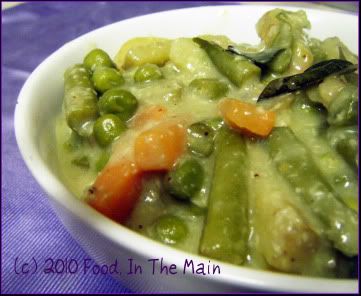
Ingredients:
3 cups mixed vegetables, sliced into 1/2-cm thick matchsticks (a combination of carrots, potatoes, green plantains, green beans, bottlegourd/squash/courgettes, peas)
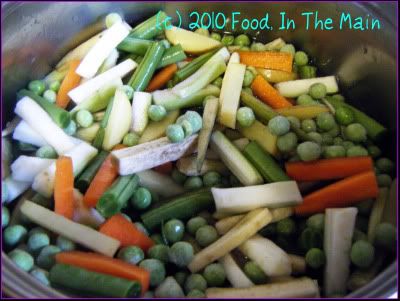
3 tbsp freshly grated coconut
4-5 green chillies (or to taste)
1/2 tsp cumin seeds
2 tbsp coconut oil 1/2 tsp tamarind paste
8-10 fresh curry leaves
salt to taste
Method:
1. Cook all the vegetables till done, but not mushy.
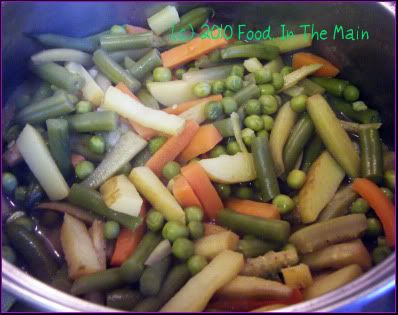
You can do this in a pressure cooker (much quicker than anyhow else) or on the hob, or in the microwave.
2. Grind together the coconut, cumin seeds and green chillies
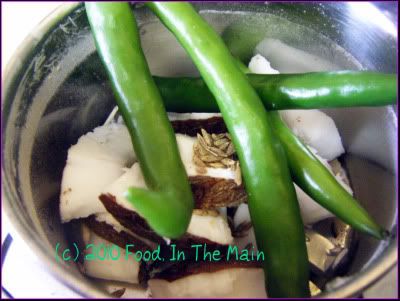
to a smooth paste using warm water.
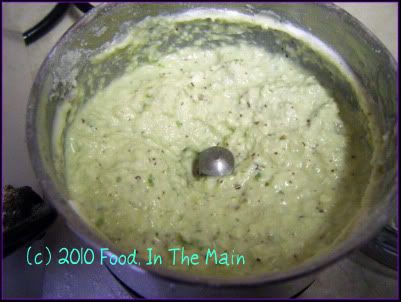
3. Add the coconut paste to the vegetables along with salt to taste, and mix well. Mix tamarind paste with 2-3 tbsp water and add that as well (increase to 1/2 cup water if there isn't enough to make a gravy).
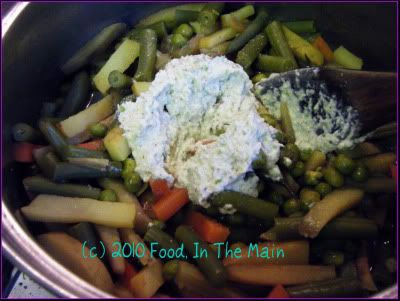
4. Sprinkle the curry leaves over, then pour in the coconut oil and mix again.
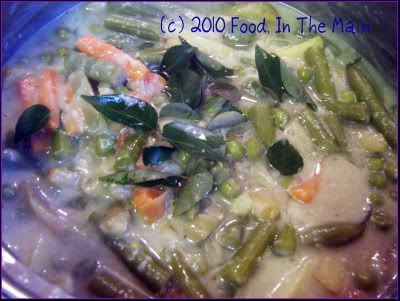
Heat the aviyal thoroughly (careful not to burn it) and serve hot with steamed rice.
There are days when trying to get some inspiration can be as elusive and exasperating an exercise as trying to grab a handful of water. The harder you try to grab it, the less there is in hand. Since my previous post, I seem to have developed the written equivalent of speechlessness. A blank page reflects a blank mind... or is it the other way around? Whatever, I decided that I would write at least one paragraph before posting a recipe (and yes, there are recipes waiting to see the light of publication, as it were) - and never mind if it has nothing to do with food or food writing.
So that was the paragraph.
And here's the recipe.
Recipe for: Tomato-vegetable rice

Ingredients:
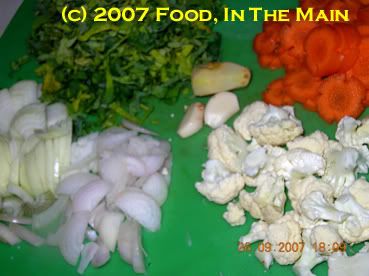
2 cups vegetables of choice, chopped (I used cauliflower, spinach and carrots)
1 large onion + 5 shallots, sliced thin (or use two onions)
1 tsp ginger-garlic paste
3 tomatoes + 1 tomato, chopped
½ cup frozen peas
1 cup loosely packed fresh coriander leaves
4-5 green chillies, slit (or as per taste)
1-1/4 cups uncooked basmati rice, soaked for 20 minutes
1 tsp coriander powder
½ tsp cumin powder
2 tsp oil
Salt to taste
A few fresh curry leaves
Water as required
Method:
1. Grind 3 tomatoes and the coriander leaves to a smooth paste. Reserve.

2. Heat the oil in a wide pan and add the green chillies, coriander and cumin powder and curry leaves. Fry for 30 seconds or so on high heat.

3. Add the sliced onions and stir, frying till the onions begin to turn translucent and pale brown.

Then add the remaining chopped tomato and let it cook till it starts to mush down.

4. Add the remaining vegetables and mix well, letting them cook on medium heat for about 4 minutes, until the spinach wilts.

5. Then add the rice (after draining all the water) to the pan

and stir on high heat till it is well mixed in.

6. Add the frozen peas now and stir them in.

7. Now measure out the ground tomato-coriander paste in a cup and pour it in. Add as much water as required to make a total of 2-1/4 cups liquid. Add salt to taste and stir it all in.

8. Let the water-tomato paste mixture come to a bubbling boil, then turn down the heat, smoothen the top and cover tightly with a lid.

9. After 20 minutes, turn off the heat. Let the pan stay covered for another 10 minutes. Then uncover, gently stir the rice mixture, and serve hot with poppadoms and raita.
A few days ago, when I went through this recipe in my inbox, my first thought was that the dish when finished would look about as unappetising as a train wreck. But I went ahead and tried it anyway, because it was a TNT (Tried 'N' Tested) recipe... which meant that the person who sent it to the food group must have tried it and liked it. The second reason was that I wasnt in the mood to make anything elaborate and this one-pot dish was just a god-send.
I'm glad I did try it, because it tasted wonderful - the top layers of cheese and ripe red tomatoes was like pizza... but then the rice layer came into its own, luscious with vegetables and loaded with flavours! The one change I would make the next time I make this, is to substitute flavoured cream cheese (garlic-chive, most probably) for the cottage cheese as originally specified in the recipe. It tasted fine, but I have to say the cottage cheese didnt look very nice because of its lumpy character. I ended up with little bumpy white flecks all over and I have to say that it was not what anybody would call "eye candy".
But the savoury bake tasted fantastic - and when you can get your carbs, veggies and proteins all from one easy dish, I for one wont be complaining! Along with its simplicity, the versatility of this dish is also something I like - you can add pretty much any vegetables you like as long as you make it two cupfuls. If you need to feed more than 3 people, just scale up the recipe as you feel fit, add an extra egg or two, and so on. The possibilities are many!
Recipe for: Savoury rice bake
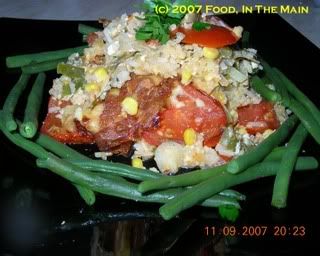
Ingredients:
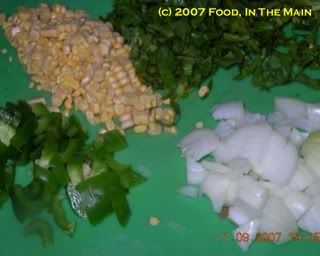
2 cups cooked or leftover rice
1 egg, beaten
2 cups mixed chopped vegetables (I used onions, bell peppers, spinach and fresh corn)
2-3 ripe red tomatoes, sliced 1/2cm thick
3/4 cup cottage cheese (or use cream cheese if preferred)
1/3 cup + 2 tbsp low-fat cheddar cheese, grated
3 tbsp sharp parmesan cheese
1 tsp smoked paprika powder
1 tsp black peppercorns, powdered
2 green chillies, minced (optional)
2 tbp fresh herbs to taste, minced (oregano, basil, parsley, etc)
Salt to taste
Method:
1. Heat the oven to 180C.
2. In a lightly greased casserole dish, put in the rice, vegetables, cottage/cream cheese, 2 tbsp cheddar, 2 tbsp parmesan, the smoked paprika, black pepper, green chillies (if using), the fresh herbs and salt to taste, and mix well.
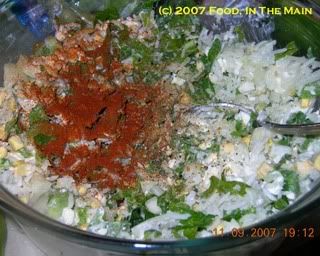
3. Check seasoning and adjust to taste, then pour in the beaten egg and mix again.

4. Smooth the top of the rice mix.
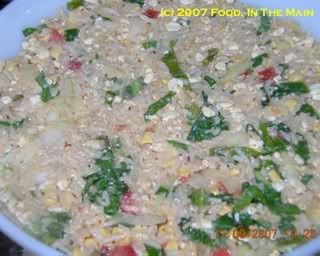
5. Now layer the sliced tomatoes in overlapping circles to cover the top of the casserole.
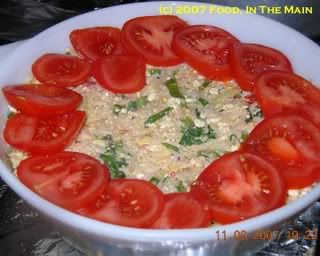
6. Sprinkle over the 1/3 cup cheddar cheese and the remaining 1 tbsp parmesan cheese.
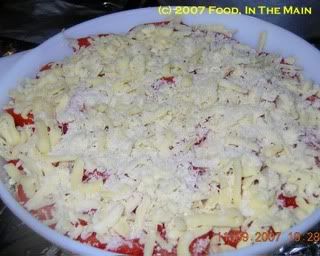
7. Bake at 180C for about 45 minutes or till the cheese is bubbling and golden.
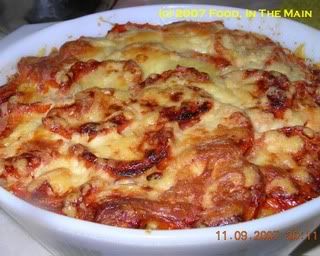
Allow the casserole to rest for 5 minutes, then serve hot along with steamed vegetables.
Finally a chance to post this recipe, which I'd printed off from Khanakhazana a few yonks ago (one yonk = unspecified amount of time somewhat less than a decade. Since it's not been officially defined, I thought I would step in. No need to thank me. Really.) and only managed to make last week. I love the flavour of sesame and the fact that it pairs perfectly with anything - sweet and savoury. Me being me, I go for savoury almost every time, although I've been known to down a few "ellu urundai" on occasion. (Note to self: Get recipe from amma.)
Apart from years of inertia, one of the other reasons it took so long to make this recipe was a long weekend spent in Scotland with a friend. (You can read about it here - but be warned it's long!). And once we got back last Monday, it seemed like Pete and I were eating out every evening thereafter, until yesterday! To think that I was kinda proud (and pleased) that we werent the "eating out kind"...
Not that I'm complaining too much, because we discovered a pretty authentic Cantonese restaurant that wasnt horribly expensive AND had great food. And an "Indian" (read Bangladeshi) one that had a unique working arrangement... basically, the time you enter the restaurant (called "Shuvecha") is the price you pay per person for a 3-course meal. So if you get there for 6pm, you pay £6 per person. If you go there at 10.30pm, you pay £10.30 per person. They do have an a la carte menu too - but the main courses listed start at £7.50 or thereabouts... so the time-wise payment is wayyyy cheaper. I wonder how the restaurant manages to make a profit.
We enjoyed our meal there because the food wasnt bad and the service was brilliant. There was this young waiter who looked about 14 years old who was really enthusiastic and friendly. When Pete praised the tandoori chicken salad he'd had as a starter, this young fella rushed off to the chef and got some cooked tandoori chicken in a box, along with the recipe, so that Pete could make himself a salad like that at home. What's more, we werent charged for this. You couldnt ask for better service, and the young man earned himself a large tip.
Oh bother, I've gone off the track (not quite off the rails though!) as usual. So before I wander any further, let me say that the sesame-flavoured savoury rice that I made was mouth-watering in aroma and flavour.
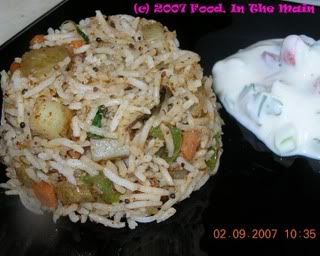
Since it was a one-pot meal, all it needed was a simple raita (I made a baby cherry tomato-cucumber raita) as an accompaniment. Yum. It was probably especially nice because I was craving home-made food after all that eating out, fun though it was!
Recipe for: Sesame vegetable rice

Ingredients:
For the sesame powder:
3 tbsp sesame seeds
6-7 dried red chillies (or to taste)
2 tbsp coriander seeds
1/2 tsp oil
For the vegetable rice:
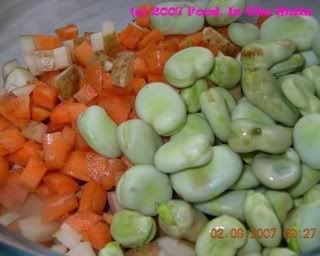
4 cups cold cooked basmati rice
1-1/2 cups mixed chopped vegetables (I used potatoes, carrots, fresh broad beans and bell pepper)
Salt to taste
For tempering:
1 tsp mustard seeds
1 tbsp chana dal
1 tbsp oil
a few curry leaves torn roughly
pinch of asafoetida
Method:
1. Roast the sesame seeds till they begin to turn pale brown.
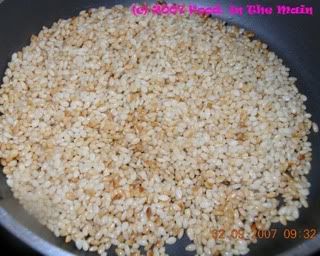
Set aside to cool completely, then grind to a powder. Be careful not to over-grind or let the motor get hot, or the sesane seeds will exude oil and become lumpy rather than powdery.
2. Heat 1/2 tsp oil and roast the red chillies and coriander seeds on low heat until they turn a darker shade and give off a nice aroma.
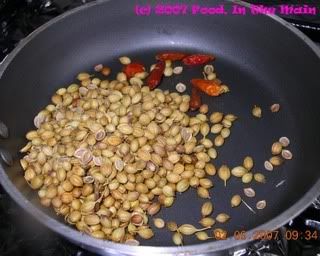
Set aside to cool, then grind to a powder. Mix with the powdered sesame seeds.
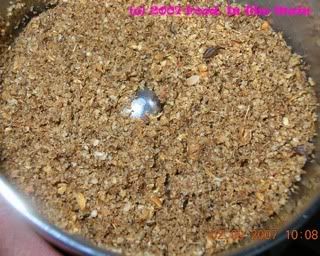
3. Cook the chopped vegetables (dont add bell pepper now, if using) in the microwave until done but not mushy.
4. In a large pan, heat 1 tbsp oil and add the tempering ingredients. Cover and let the mustard seeds pop.

Add the chopped bell pepper now, if using.
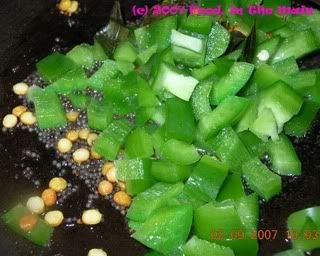
5. Let the bell peppers cook for 4 minutes, then add the cooked vegetables, mix well and fry, stirring once or twice, for another 3-4 minutes.

6. Add the sesame seed powder, along with salt to taste, and mix well.
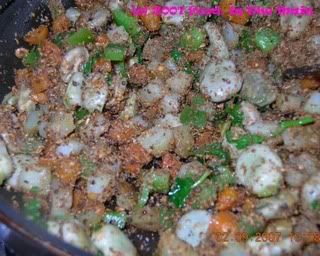
7. After a couple of minutes, add the cooked rice and carefully mix it with the vegetables, without breaking the grains.
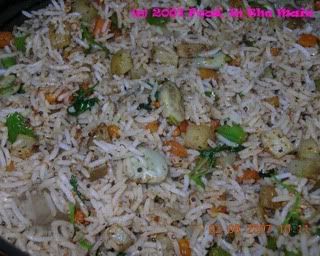
Once the rice is heated through, sprinkle with chopped coriander and serve hot with a nice cool raita and vadam/appalam/crisps.
This is a classic South Indian recipe, one made probably in every home. And equally probably it will vary slightly from home to home, never really exactly the same anywhere.
I've done my version (or rather, my mom's version - actually, probably my grandmother's version and so on upwards!) earlier, except that in my family it's called "poricha kuzhambu" and it varies ever so slightly from Kiwi Gee's. For instance, I've never known it to have pureed tomatoes in it, or ginger, and it's one of the few items we make that doesnt have coriander leaves as garnish!
But, as I already said, each to his/her own. And, as Kiwi Gee says, it's "Esply good for rotis on ‘onionless’ days. Nowadays, it is a boon to me as I get my veggies and dhal into one simple dish that is quick to cook and nutritious to eat. And easy to camouflage the veggies in all that dhal, esply as far as feeding the hungry hordes (kids) goes".
So there you are - a way to get those dreaded veggies into your kids, if you have them (kids, I mean). If you dont, it's merely a good way to incorporate all the odds and ends of vegetables that you might have in the fridge. Either way, a good recipe to have on hand. ("This koottu can be made with different veggies – white pumpkin, carrots, frozen mixed veggies, cabbage, spinach, zucchini, etc. ")
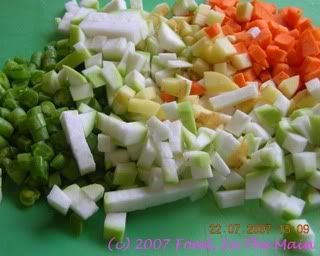
Kiwi Gee used "choko" (in the strange language of Down Under *wink* it refers to chayote squash/Bangalore kathirikkai!), but I didnt have any on hand as it's not a vegetable that's seen in the local supermarkets. Luckily I did have a half of doodhi (bottle gourd), so I used that in its place. Also added a chopped carrot, a potato, some green beans and, at the very end of cooking, frozen green peas. (What's life without green peas, eh?).
Recipe for: Poricha kootu
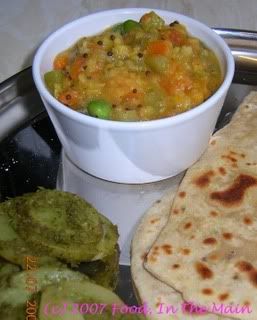
2 cups chopped mixed veggies (any combination of potatoes, carrots, green beans, chayote squash, eggplant - if you absolutely must - etc)
1/4 cup moong dal
Salt to taste
Turmeric powder (a pinch)
1 tsp oil
For the seasoning:
Coriander leaves
Curry leaves
1 tsp Mustard seeds
1 tsp channa dal
1 tsp urad dal
pinch asafoetida powder
For the paste:
2-4 green chillies
1 tsp cumin seeds
2 tbsp grated ococonut
5 pepper corns
Small piece of ginger
1 large tomato (or two medium ones)
Method:
1. Wash the moong dal, drain and add a cupful of water along with the vegetables and a pinch of turmeric powder.
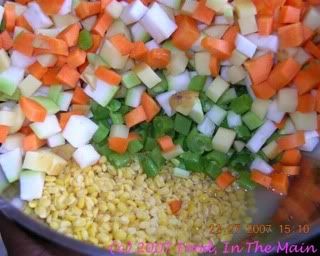
2. Pressure cook the vegetables and the moong dal for 3 whistles or until the dal is well mushy. Set aside.
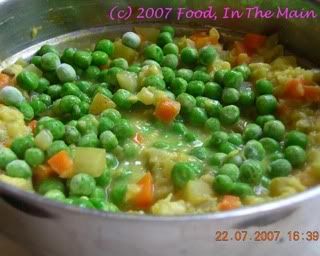
3. Chop tomatoes into small bits and grind to a fine paste along with ginger, green chillies, cumin seeds, coconut and pepper corns – grind raw.
4. In a kadhai, heat the oil, add the hing powder, mustard seeds, channa and urad dhal and curry leaves.
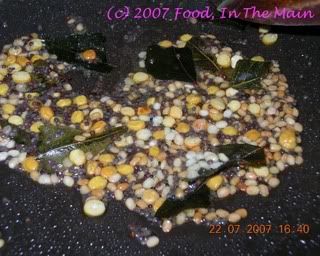
5. When mustard pops and dhals are reddish, add the paste.
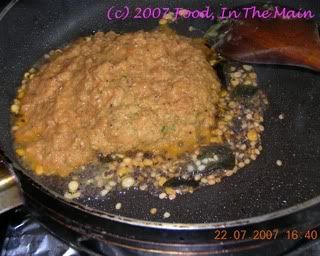
6. Fry for a minute, then add the pressure cooked vegetables and dhal along with the frozen peas if using.
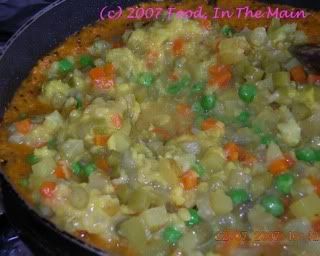
7. Keep stirring till it all comes to a boil (adding water if reqd to keep it at a pouring consistency), then add salt, mix and switch hob off.
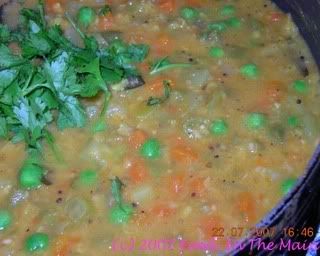
8. Sprinkle chopped coriander on top. Use as a side dish with rice or rotis.
Funnily enough, there isnt much I can say about this recipe (do I hear a collective sigh of relief?) :) It's simple, filling, aromatic, low-fat and has plenty of vegetables - not much else to ask of a dinner dish, is there? This pulao is one step down from a khichdi, the missing ingredient being tuvar dal. I didnt add it because I wasnt sure if the tuvar dal would cook completely in the microwave.
I'm a bit wary of cooking dals in the microwave because the one time I tried it with tuvar dal, it made an unholy mess when it bubbled over in the oven - and it STILL was only half-cooked. While lots of things are nice al dente instead of mushy, tuvar dal is not on that list.
We had this nearly-khichdi vegetable pulao with a simple tomato raita, but it would be just as nice with coconut chutney or some spicy pickle alongside.
Recipe for: Microwave vegetable pulao

Ingredients:
1 cup basmati rice, soaked in warm water for 30 minutes
2 cups mixed chopped vegetables (any combination of green beans, carrots, spinach, cauliflower, peas, etc)
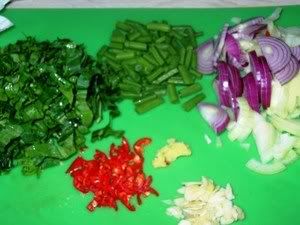
1 onion, sliced thin
1 bay leaf
1 medium-hot red chilli, sliced into very thin rings
3-4 green chillies, slit (optional or adjust to taste)
1/2 tsp garam masala
1 tsp cumin seeds
1 tsp slivered garlic (2-3 pods)
1 tsp ginger root, grated
2 tsp oil
Salt to taste
1 tbsp coriander leaves, to garnish
Handful of roasted/fried cashewnuts, for garnish (optional)
Method:
1. Heat the 2 tsp oil in a pan and add the bay leaf, garlic, grated ginger, slit chillies, sliced red chilli and cumin seeds. Fry for 30 seconds or so, stirring continuously.
2. Add the garam masala and onions and stir-fry till they start turning soft, then add the vegetables and stir again.
3. Drain the rice and add that to the pan as well and fry for 2-3 minutes.
4. Add 2-1/4 cups water and salt to taste. Pour it all into a microwaveable bowl and cook it for 15 minutes or so on high without a cover. (Start with 10 minutes and see if the vegetables and rice are cooked - the cooking time depends on the wattage of the oven.)

5. Cover the bowl and let the pulao rest for 5 minutes. Just before serving, fluff the rice up gently with a fork and sprinkle the chopped coriander over. Also top with the fried cashewnuts, if using.
Serve hot with chilled tomato-yogurt raita.
Quick tomato raita:
1 ripe tomato, chopped fine
1 cup cold yogurt (Greek-style, for preference)
1/4 tsp salt
pinch of garam masala (or molagapodi if you have it)
Mix together and serve as an accompaniment for the pulao.


















































